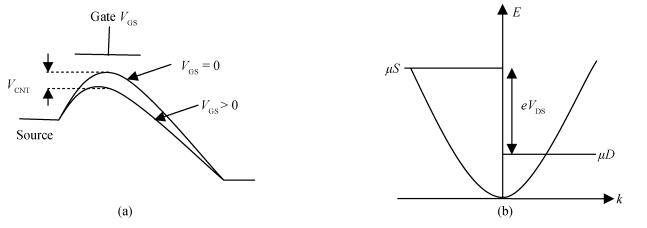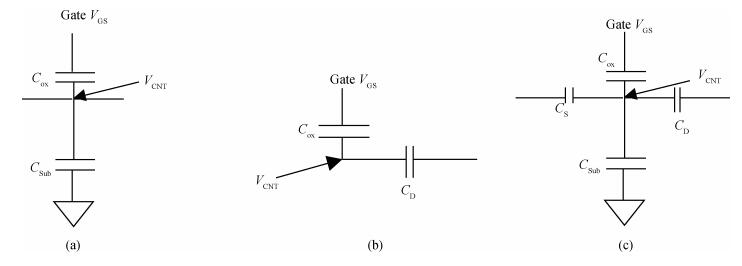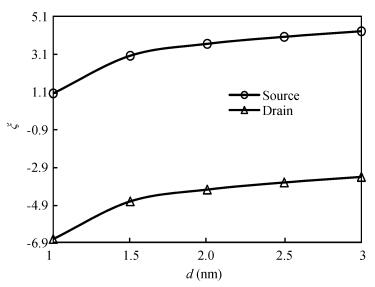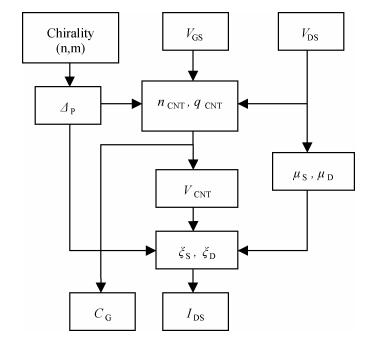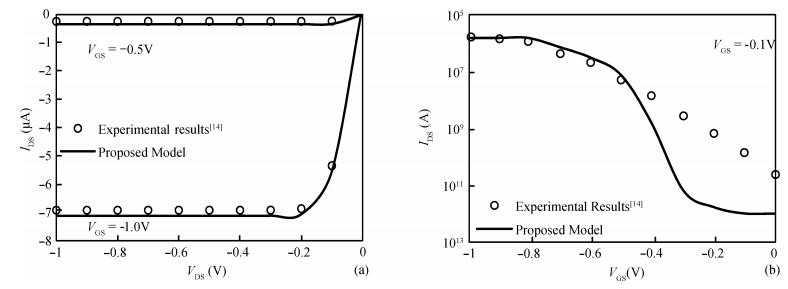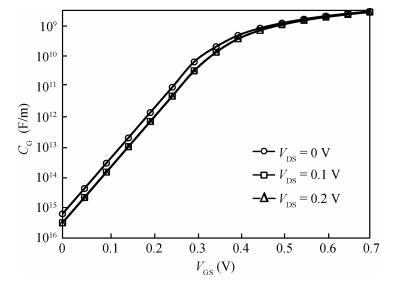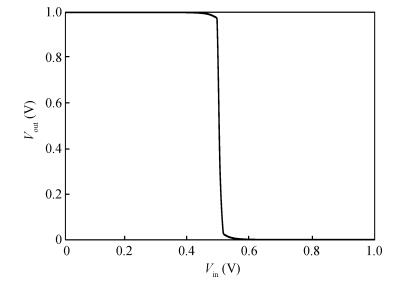| Citation: |
Amandeep Singh, Mamta Khosla, Balwinder Raj. Compact model for ballistic single wall CNTFET under quantum capacitance limit[J]. Journal of Semiconductors, 2016, 37(10): 104001. doi: 10.1088/1674-4926/37/10/104001
****
A m and E Singh, M Khosla, B Raj. Compact model for ballistic single wall CNTFET under quantum capacitance limit[J]. J. Semicond., 2016, 37(10): 104001. doi: 10.1088/1674-4926/37/10/104001.
|
Compact model for ballistic single wall CNTFET under quantum capacitance limit
DOI: 10.1088/1674-4926/37/10/104001
More Information
-
Abstract
This paper proposes a compact model for carbon nanotube field effect transistor (CNTFET) based on surface potential and conduction band minima. The proposed model relates the I–V characteristics to chirality under quantum capacitance limit. C–V characteristics have been efficiently modelled for different capacitance models which are used to find the relationship between CNT surface potential and gate voltage. The role of different capacitances is discussed and it has been found that the proposed circuit compact model strictly follows quantum capacitance limit. The proposed model is efficiently designed for circuit simulations as it denies self-consistent numerical simulation. Furthermore, this compact model is compared with experimental results. The model has been used to simulate an inverter using HSPICE. -
References
[1] Iwai H. Roadmap for 22 nm and beyond. Microelectron Eng, 2009, 86(7): 1520 http://cn.bing.com/academic/profile?id=2062598185&encoded=0&v=paper_preview&mkt=zh-cn[2] Dresselhaus M S, Dresselhaus G, Saito R. Physics of carbon nanotubes. Carbon, 1995, 33(7): 883 doi: 10.1016/0008-6223(95)00017-8[3] Hong Li. Circuit modelling and performance analysis of multiwalled carbon nanotube interconnects. IEEE Trans Electron Devices, 2008, 55(6): 1328 doi: 10.1109/TED.2008.922855[4] Lin Y M, Appenzeller L, Knoch L, et al. High-performance carbon nanotube field-effect transistor with tunable polarities. IEEE Trans Nanotechnol, 2005, 4(5): 481 doi: 10.1109/TNANO.2005.851427[5] Javey A, Guo J, Wang Q, et al. Ballistic carbon nanotube fieldeffect transistors. Nature, 2003, 424(6949): 654 doi: 10.1038/nature01797[6] Fregonese S, d'Honincthun H C, Goguet J, et al. Computationally efficient physics-based compact CNTFET model for circuit design. IEEE Trans Electron Devices, 2008, 55(6): 1317 doi: 10.1109/TED.2008.922494[7] Appenzeller J. Comparing carbon nanotube transistors–the ideal choice: a novel tunneling device design. IEEE Trans Electron Devices, 2005, 52(12): 2568 doi: 10.1109/TED.2005.859654[8] Javey A, Kim H, Brink M, et al. High-k dielectrics for advanced carbon nanotube transistors and logic. Nature Materials, 2002, 1(4): 241 doi: 10.1038/nmat769[9] Rahman A, Guo J, Datta S, et al. Lundstrom:theory of ballistic nanotransistors. IEEE Trans Electron Devices, 2003, 50(9): 1853 doi: 10.1109/TED.2003.815366[10] Guo J, Lundstrom M, Datta S. Performance projections for ballistic carbon nanotube field-effect transistors. Appl Phys Lett, 2002, 80(17): 3192 doi: 10.1063/1.1474604[11] Raychowdhury A, Mukhopadhyay S, Roy K. A circuitcompatible model of ballistic carbon nanotube field-effect transistors. IEEE Trans Comput-Aided Des Integr Circuits Syst, 2004, 23(10): 1411 doi: 10.1109/TCAD.2004.835135[12] Dwyer C, Cheung M, Sorin D J. Semi-empirical SPICE models for carbon nanotube FET logic. Proc 4th IEEE Conf Nanotechnol, 2004: 386[13] Natori K, Kimura Y, Shimizu T. Characteristics of a carbon nanotube field-effect transistor analyzed as a ballistic nanowire fieldeffect transistor. J Appl Phys, 2005, 97(3): 034306 doi: 10.1063/1.1840096[14] Seidel R V, Graham A P, Kretz J, et al. Sub-20 nm short channel carbon nanotube transistors. Nano Lett, 2005, 5(1): 147 doi: 10.1021/nl048312d[15] Wang Wei, Zhang Lu, Wang Xueying, et al. The combined effects of halo and linear doping effects on the high-frequency and switching performance in ballistic CNTFETs. Journal of Semiconductors, 2014, 35(11): 114004 doi: 10.1088/1674-4926/35/11/114004[16] Iijima S. Helical microtubules of graphitic carbon. Nature, 1991, 354(6348): 56 doi: 10.1038/354056a0[17] Singh K, Raj B. Temperature-dependent modelling and performance evaluation of multi-walled CNT and single-walled CNT as global interconnects. Journal of Electronic Materials, 2015, 44(12): 4825 doi: 10.1007/s11664-015-4040-x[18] Guo J, Datta S, Lundstrom M. Assessment of silicon MOS and carbon nanotube FET performance limits using a general theory of ballistic transistors. Proc Electron Devices Meeting, 2002: 711[19] Wind S J, Appenzeller J, Avouris P. Lateral scaling in carbon nanotube field-effect transistors. Phys Rev Lett, 2003, 91(5): 058301 doi: 10.1103/PhysRevLett.91.058301[20] Yao Z, Kane C L, Dekker C. High-field electrical transport in single-wall carbon nanotubes. Phys Rev Lett, 2000, 84(13): 2941 doi: 10.1103/PhysRevLett.84.2941[21] Mintmire J W, White C T. Universal density of states for carbon nanotubes. Phys Rev Lett, 1998, 81(12): 2506 doi: 10.1103/PhysRevLett.81.2506[22] Streetman B, Banerjee S. Solid state electronics devices. 6th ed. Prentice Hall, 2000, 4: 89[23] Prado J M M. Current transport modelling of carbon nanotube field effect transistors for analysis and design of integrated circuits. PhD dissertation, Louisiana State University, Baton Rouge, USA, 2008[24] Kazmierski T J, Zhou D F, Al-Hashimi B M, et al. Numerically efficient modelling of CNT transistors with ballistic and nonballistic effects for circuit simulation. IEEE Trans Nanotechnol, 2010, 9(1): 99 doi: 10.1109/TNANO.2009.2017019[25] Guo J, Lundstrom M, Datta S. Performance projections for ballistic carbon nanotube field-effect transistors. Appl Phys Lett, 2002, 80(17): 3192 doi: 10.1063/1.1474604[26] NANOHUB Online simulations and moreNanoTCAD ViDES [Online]. Available: https://nanohub.org/tools/vides.[27] Raychowdhury A, Mukhopadhyay S, Roy K. A circuitcompatible model of ballistic carbon nanotube field-effect transistors. IEEE Trans Comput-Aided Des of Integrd Circuits Syst, 2004, 23(10): 1411 doi: 10.1109/TCAD.2004.835135[28] Sinha S K, Chaudhury S. Comparative study of leakage power in CNTFET over MOSFET device. Journal of Semiconductors, 2014, 35(11): 114002 doi: 10.1088/1674-4926/35/11/114002[29] Yang X B, Mohanram K. Modelling and performance investigation of the double-gate carbon nanotube transistor. IEEE Electron Device Lett, 2011, 32(3): 231 doi: 10.1109/LED.2010.2095826[30] Frégonèse S, Maneux C, Zimmer T. A compact model for dualgate one-dimensional FET: application to carbon-nanotube FETs. IEEE Trans Electron Devices, 2011, 58(1): 206 doi: 10.1109/TED.2010.2082548 -
Proportional views






 DownLoad:
DownLoad:

